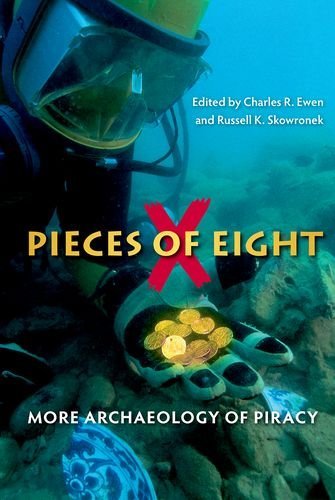The Pieces of Eight: More Archaeology of Pirates
Edited by Charles R. Ewen and Russell K. Skowronek
 A sequel to X Marks the Spot (2007), Pieces of Eight, edited by Charles Ewen and Russell Skowronek, brings together evidence of piracy from around the world from the seventeenth and eighteenth centuries. Ewen, an anthropology professor at East Carolina University, and Skowronek, an anthropology professor at University of Texas-Pan American, have previously worked on sites linked to piracy and previously edited X Marks the Spot.
A sequel to X Marks the Spot (2007), Pieces of Eight, edited by Charles Ewen and Russell Skowronek, brings together evidence of piracy from around the world from the seventeenth and eighteenth centuries. Ewen, an anthropology professor at East Carolina University, and Skowronek, an anthropology professor at University of Texas-Pan American, have previously worked on sites linked to piracy and previously edited X Marks the Spot.
The anthology that Ewen and Skowronek have assembled reflects a variety of methodologies used to understand a group of people who are challenging to identify in the archaeological record. The main theme of the collection focuses on the potential for identifying piracy in the archaeological record, whether that be underwater shipwreck sites or terrestrial landscapes or the liminal space of the coastlines, and comparing real pirates to their Hollywood stereotypes. By providing a common theme of identifying piracy and its role in the world, Ewen and Skowronek provide an engaging account of piracy around the world through the latest discoveries in Panama, the Dominican Republic and Ireland and further research in North Carolina, Jamaica and Madagascar.
The editors compiled a variety of different research from all over the known Golden Age of Piracy haunts to discuss the feasibility of identifying pirates in the archaeological record and breaking the Hollywood myths of piracy. The articles flow from one pirate haven to another, focusing on Queen Anne’s Revenge in North Carolina, Fiery Dragon in Madagascar, Ranger in Jamaica, Quedagh Merchant in the Dominican Republic, Morgan’s raiding of Panama, and the multitude of pirates in Ireland. The use of different sites offers a way for the editors to reach their goal of linking piracy together around the world, establishing methodologies for finding piracy in the archaeological record, and providing a means of creating an accurate image of piracy. This image shows that pirates were living in a real world filled with danger and excitement, yet they lived just as every other sailor in the seventeenth and eighteenth centuries, making them hard to identify in the archaeological record. This image was compared to Hollywood’s version of piracy. Through the chapters focusing on pirates as providers and their indeterminable presence in the archaeological record, the research offers the beginning attempts to break the Hollywood stereotype.
The editors complied a well-written body of research. Each article convincingly argues the difficulties in finding the remains of pirates in the archaeological record, whether those be terrestrial or underwater. Unlike its predecessor anthology, this compilation does not divide the research into explicit sections. This lack of explicit division, however, provides a more dynamic read about the intricacies of pirate archaeology through the variety of sites presented in nondiscriminatory manner. By using sites throughout the world in no manner of importance, the editors have created a gripping tale of pirate archaeology. Although, as one author states “it is not possible to discern a definitive artifact pattern for pirate shipwreck,” Ewen and Skowronek have offered up the beginnings for future research into pirates in the archaeological and historical record.
- Gainesville: University Press of Florida, 2016
- 6-1/2” x 9-1/2”, hardcover, xvii + 318 pages
- Illustrations, maps, tables, notes, references, index. $39.95
- ISBN: 97808130615890
Reviewed by Allyson Ropp, East Carolina University
